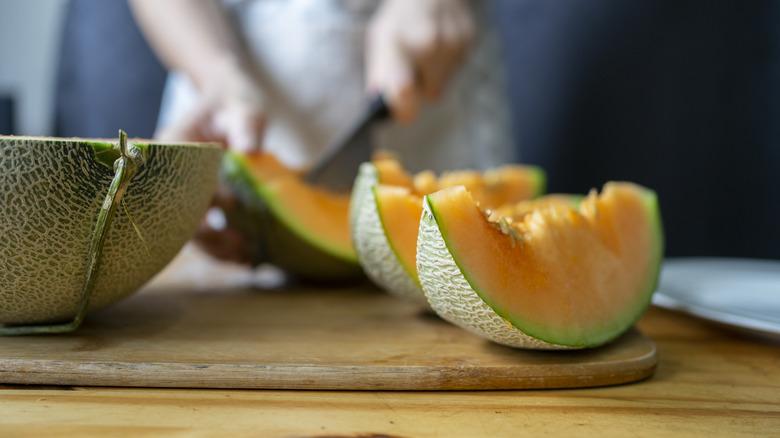If A Cantaloupe Is Not Ripe In The Grocery Store, Don't Buy It. Here's Why
If you've ever chosen a cantaloupe from the grocery store, thinking it would get sweeter sitting on your kitchen counter, you are not alone. A lot of people assume melons ripen in a similar way as bananas — just leave them out for a few days and they will end up sweet, aromatic, and perfectly tender for eating. Unfortunately, when it comes to cantaloupe, it does not work that way. The truth is, once these melons are picked from the vine, they do not continue to ripen in the standard way you would expect. They can soften a bit and become a little more fragrant and juicy over time — but the desired sweetness is pretty much locked in as soon as they are harvested. That means a lot when choosing a cantaloupe: If it's not ripe and sweet sitting in that grocery bin, it won't ever be sweet inside your kitchen.
It all comes down to cantaloupes falling within a category called non-climacteric fruits. After being picked, non-climacteric fruits, such as many citrus fruits, berries, and some types of melons, do not continue producing ethylene gas, a natural plant hormone that triggers ripening. The sugar content of cantaloupes is also determined while still attached to the vine, which explains why they will never get sweeter after cutting that cord. The opposite category is climacteric fruits such as tomatoes, bananas, mangoes, and avocados, which continue to release ethylene and ripen after harvest. However, a bit of good news is that non-climacteric fruits like cantaloupes may last longer because they're no longer actively "respiring" and therefore deteriorate more slowly.
Choosing a cantaloupe that's sweet, juicy, and ready to eat
It pays to choose wisely when buying cantaloupes in grocery stores. Nobody wants to slice open that webbed rind and find bland-tasting flesh with no sweetness or aroma — especially since, unlike other types of fruits, the cantaloupe is not going to change much once purchased. Plenty of cantaloupe hacks exist, some of which are useful, but if you truly want to choose the perfect cantaloupe, here are some tried-and-true ways to achieve that.
It's all about sensory characteristics when evaluating the ripeness level of a cantaloupe. You'll be seeing, touching, listening to, and smelling the whole cantaloupe long before you taste it at home. First up is assessing the weight. If feels lighter than expected or has a hollow sound when thumping, there is a good chance it is not ripe enough for eating. Density can instead indicate juicy sweetness. The rind should give a bit when gently pressed, and the netting will ideally be well-defined and slightly coarse to the touch.
Spend some time checking out the stem scar on top and its opposite, the blossom end. If the stem scar is smooth, that indicates a "full slip," meaning it was allowed to fully ripen before being detached from the vine. The blossom spot on the other end should give slightly when applying pressure. Make a visual inspection for color, where you will want to see a creamy yellow or light tan background beneath the netting. Finally, there's the all-important aroma of a ready-to-eat cantaloupe: heady, musky, and wonderfully sweet.

